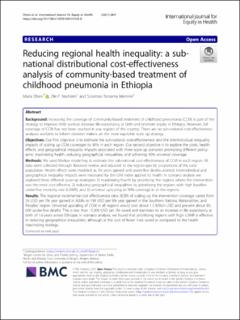Reducing regional health inequality: a subnational distributional cost-effectiveness analysis of community-based treatment of childhood pneumonia in Ethiopia
Journal article, Peer reviewed
Published version

Åpne
Permanent lenke
https://hdl.handle.net/11250/2767514Utgivelsesdato
2021Metadata
Vis full innførselSamlinger
Sammendrag
Background
Increasing the coverage of community-based treatment of childhood pneumonia (CCM) is part of the strategy to improve child survival, increase life-expectancy at birth and promote equity in Ethiopia. However, full coverage of CCM has not been reached in any regions of the country. There are no sub-national cost-effectiveness analyses available to inform decision makers on the most equitable scale up strategy.
Objectives
Our first objective is to estimate the sub-national cost-effectiveness and the interindividual inequality impacts of scaling up CCM coverages to 90% in each region. Our second objective is to explore the costs, health effects, and geographical inequality impacts associated with three scale-up scenarios promoting different policy-aims: maximizing health, reducing geographical inequalities, and achieving 90% universal coverage.
Methods
We used Markov modelling to estimate the sub-national cost-effectiveness of CCM in each region. All data were collected through literature review and adjusted to the region-specific proportions of the rural population. Health effects were modeled as life years gained and under-five deaths averted. Interindividual and geographical inequality impacts were measured by the GINI index applied to health. In scenario analysis we explored three different scale-up strategies: 1) maximizing health by prioritizing the regions where the intervention was the most cost-effective, 2) reducing geographical inequalities by prioritizing the regions with high baseline under-five mortality rate (U5MR), and 3) universal upscaling to 90% coverage in all the regions.
Results
The regional incremental-cost effectiveness ratio (ICER) of scaling up the intervention coverage varied from 26 USD per life year gained in Addis to 199 USD per life year gained in the Southern Nations, Nationalities, and Peoples’ region. Universal upscaling of CCM in all regions would cost about 1.3 billion USD and prevent about 90,000 under-five deaths. This is less than 15,000 USD per life saved and translates to an increase in life expectancy at birth of 1.6 years across Ethiopia. In scenario analysis, we found that prioritizing regions with high U5MR is effective in reducing geographical inequalities, although at the cost of fewer lives saved as compared to the health maximizing strategy.
Conclusions
Our model results illustrate a trade-off between maximizing health and reducing health inequalities, two common policy-aims in low-income settings.
